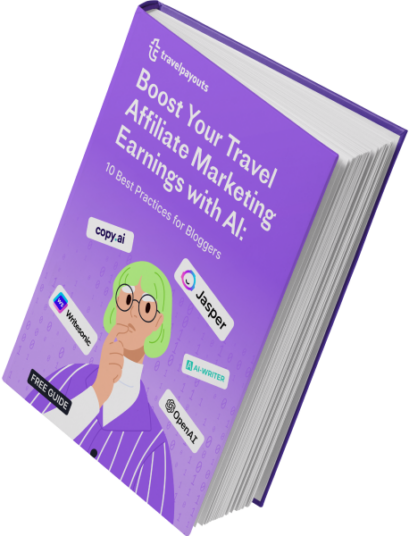What Is AI Content?
Before we dive into the myths about AI content, we should probably provide a baseline understanding of what it is first, right?
AI is a collection of systems, data, and technology that can mimic tasks that require human intelligence — from graphic design and copywriting to language translation and driving. More specifically, AI content writing tools (like ChatGPT and Jasper AI) are pieces of software that can create human-like text with the power of AI technology.
AI writing tools take a user-generated input and create an AI-generated output. Since they are receiving information from a human, they can mimic a human writer’s general voice and tone.
Why Should Travel Bloggers Care About AI Content?
As a travel blogger or content creator, you may be concerned about the rising popularity and continued improvement of AI writing systems. After all — writing informative blog posts, creating interesting captions for social media, and generating original content is your career. You may ask yourself — is ChatGPT going to replace my job?
We’ll dive into that thought in-depth in a minute (hint: the answer is no), but first, we wanted to explain some ways that AI writing tools can make your job as a travel blogger or content creator easier and prove to you that it can actually enhance your content.
AI writing tools can enhance marketing campaigns and can be used to create blog outlines, social media captions, email headlines, and blog content — just to name a few. By taking advantage of AI writing tools, you can unlock the following benefits:
- Automate and speed up content creation
- Complete repetitive or mundane tasks with ease
- Generate ideas to overcome writer’s block
- Save time and energy by focusing on other tasks
Common Myths About AI Content
As we mentioned earlier, there are plenty of myths that have been generated (and embraced) about AI-generated content — and some of these misconceptions may be so convincing that they have caused you to steer clear of AI writing tools altogether.
In this post, we will identify and analyze the most common misconceptions about AI writing tools to help travel bloggers and content creators (just like you!) sort out facts from fiction.
Myth #1: AI Content Can Replace Humans
One of the biggest myths (and fears) surrounding AI writing tools is that they will replace human writers. However, we are here to assure you — that is impossible!
AI writing tools can gather information, generate ideas, and produce text. However, they cannot replace the job of content creators, whose work requires critical thinking and creativity. The content generated by AI tools is becoming higher quality, but it can never match the quality of content generated with a “human touch.” Plus, these tools can’t work without you. If Jasper AI, ChatGPT, or other AI writing tools don’t have a command — they can’t generate content.
Bloggers and content creators understand their audience in a way that AI writing tools never will. They know the tone of voice that matches their brand, what types of content their audience wants, and how to infuse their personal experience into their blogs, captions, and other content in a helpful way that resonates with their readers.
AI content writing tools work best when utilized by an experienced content creator. You still need to research, fact-check, edit, and proofread AI-generated content since it is not always factually accurate or grammatically correct. Plus, the more information you can input into the AI writing tool — the better the outcome. In fact, that kind of thorough research and editing can only be completed by an intelligent human writer or content creator.
Look at the two paragraphs below for a blog post about the 10 Best Wine Tours in Temecula. The first was created by ChatGPT (an AI writing tool), and the second was embellished, fact-checked, and edited by a human writer (Travel by Brit). Which paragraph do you find more compelling, informative, and “to the point”? Chances are — it’s the one with a human touch.

The paragraphs below were generated by a human writer about the same wine tour listed above. Notice how this excerpt contains more personality and more details while still being shorter and cutting the “fluff” — which is something only a human writer can do.

Myth #2: AI Content Is Low-Quality
Now, don’t get us wrong. AI-generated content may not be as thorough, detailed, and on-brand as content created by a human writer — but that doesn’t mean the writing is low quality. AI-generated content is designed to be high-quality and engaging!
AI writing tools are just that — tools in your “content creation toolbox.” They are not magic lamps that will spit out perfect paragraphs, captions, and blog posts with a touch of a button. In fact, the quality of content created by AI tools dramatically depends on research, facts, and information provided by the user (that’s you!).
The key to creating high-quality content using AI tools is to provide detailed prompts (or commands). Here are some tips for creating suitable prompts:
- Offer context about what you’re asking the AI tool to generate — whether that be a paragraph for a blog post or a caption for Instagram.
- Include helpful facts & research you would like the AI writing tool to include in the final piece. Remember, AI tools are not factually accurate, so any “fact” it generates on its own will need to be fact-checked by you, the content creator.
- Give examples of what you’re looking for in a response. For instance, you could copy and paste a paragraph from a blog and explain that the former section is “your style.” Then, you could command the tool to write a paragraph for a blog post in that style.
- Share the length of the response you need the AI tool to generate — for example, a caption that is 150 words and a blog post that is 1,000 words is a big difference!
Let’s look at the difference prompts make in generating high-quality content by writing an introduction to a blog post together. For example, here is a response that ChatGPT generated with the prompt: “Write about the Kentucky Bourbon Trail.”

It’s not bad, right? However, it doesn’t read much like an introduction (it is a little long and choppy) and includes too much information. The response reads more like an essay than an introduction to a blog post. For example, you don’t need to know about the self-guided tours and guided tours off the bat — you can get into that in the body of your post. It also doesn’t match the writer’s tone of voice (it’s pretty generic) and isn’t very conversational.
However, compare this output to the following output, generated with this prompt: “Write a 150-word introduction for a blog post in Brittany’s style about the Kentucky Bourbon Trail. Include that Kentucky produces 95% of the world’s bourbon, there are 42 distilleries to explore on the trail, and the Woodford Reserve Distillery, Buffalo Trace Distillery, and Maker’s Mark Distillery are a few of the most popular. Mention that you can embark on a tour of the Kentucky Bourbon Trail from both major cities in Kentucky – Louisville and Lexington.”

Now, that’s a much better introduction, right? It’s more conversational, has a better flow, includes accurate statistics, and contains just enough information to hook the reader. And the only difference between the two outputs was writing a more detailed and specific prompt!
Myth #3: Google Search Bans AI Content
Many travel bloggers and content creators have steered clear of AI generated blog content for one reason — they were afraid Google would punish them for using AI-generated content. And as a blogger, you already know the key to success is staying in the “good graces” of Google!
Well, we have good news for you. Google announced that AI content is no longer against their guidelines, and they are focusing on the quality of the content rather than how the content is produced. Instead, you should focus on creating reliable, helpful, original, “people-first” content — whether AI generates it or not. The only AI content that Google will penalize is spammy content that doesn’t satisfy user intent and E-E-A-T standards.
E-E-A-T stands for experience, expertise, authority, and trustworthiness, and incorporating these elements into your posts is one of the best ways to ensure your content (AI-generated or not!) ranks on Google’s search engine. Here is a breakdown of how you can incorporate these components into your content:
Experience
You should have personal experience with the product, service, or topic being promoted in your blog post to rank on Google.
For example, if you’re writing about hiking trails in Washington, but you’ve never been to the state, Google will rank someone’s post who can demonstrate personal experience. It’s important to include details from your own experience, like tips, tricks, and personal favorites, to rank.
Expertise
Does Google see you as an expert in the topic you write about? If you’re a travel blogger with dozens of blogs on your website about traveling in the United States, Google will likely rank your post detailing the “Best Restaurants in New York City” before it ranks a post about the “Best Young Adult Books in 2023.”
It’s vital to stay on-topic and within your area of expertise when creating posts for your website. Plus, your expertise on your topic will grow over time. That’s why it takes newer bloggers a bit longer to rank. Google needs to recognize you as an expert before ranking your content for other readers.
Authority
As a travel blogger, Google must see you as an authority in the travel industry. You can build up your website as an authority by gaining backlinks from relevant, authoritative sources in the travel industry, like Travel + Leisure and Lonely Planet, and other established travel blogs.
Trustworthiness
If you can create blog posts with experience, expertise, and authority, Google will see that your website and you, as a creator, are trustworthy.
Sometimes, the text generated by AI tools, like ChatGPT or Jasper AI, won’t incorporate all the E-E-A-T components. It’s practically impossible for an AI tool to include your personal experience or demonstrate your expertise on a topic unless you feed it the information in a well-written input or command.
As a content creator, you are responsible for editing your content to incorporate all the elements needed by Google to recognize your AI-generated post as original, high-quality content.
Myth #4: AI Content Is Not Original
As we just mentioned, Google values original, helpful, high-quality content. So, if AI content weren’t original, it wouldn’t rank well on search engines, right?
One of the most common myths about AI-generated content is that it is plagiarized. While AI tools can pull information from the top sources on Google, it does not recycle language or creative ideas. AI content tools produce original content in seconds!
For example, look at the AI content produced by ChatGPT and Jasper AI that was run through Grammarly’s Plagiarism Detector. Both paragraphs pass with flying colors — proving that you can count on AI content to be 100% original.


Myth #5: AI Content Is Time-Consuming & Hard to Create
Many people believe that AI tools are more work than they’re worth — after all, you still have to research, fact-check, and edit all the outputs, so why not just write the content yourself? Well, if you’re brand-new to AI writing — there is some truth to this misconception.
Your first attempt won’t be perfect with any new thing you try — from long-distance running to learning a new language. However, you will inevitably improve over time if you stay consistent. Then, in a few months (or years), you can run the marathon or speak the language fluently — just from hard work and consistency!
Learning how to use AI writing tools isn’t much different. It will probably take you a few months to get the “hang” of how to use these tools, but once you understand how they work, they can help you create content for your website, blog, social media platforms, and email list more quickly and efficiently than you could on your own.
When you’re learning to use AI writing tools, it’s important to try out different tools to see which one works best for you. If you’re curious about the pros and cons of two of the most popular AI writing tools — ChatGPT and Jasper AI — you can read our post detailing a travel blogger’s first-hand experience using each platform to create content for her blog. If you’re looking for more AI tools to try, read this post about the best AI content writing tools for travel bloggers.
Nina Clapperton, the founder of She Knows SEO, also shared her knowledge in an informative webinar with Travelpayouts about using Jasper AI to create engaging articles that rank high on Google’s search results. Nina shared that it took her about a month to learn how to use Jasper AI with no help, and she mentioned that it now takes about an hour (from start to publish) to complete a blog post using an AI writing tool.
Myth #6: AI Assistants Break the Goal of Blogging
One of the most significant controversies about AI writing tools is that they diminish the purpose of blogging or content creation, which is writing creative, informative posts. Well, while there may be some truth to this statement, we can debunk this myth for two reasons.
First, AI writing tools only work as hard as you do. Your research, editing, personalization, and tone of voice make your blog post unique — not the AI tool. With this in mind, AI writing assistants are just like any other tools (SEO optimization, keyword research, grammar checkers, etc.) you would use to write blog posts. You still have to feed the AI tool information about your personal experience and from your research — precisely what you would do if you were writing the content without an AI tool. You’re just having someone (or something) else write it for you. It’s not much different than hiring a writer to create content for your blog.
Second, we have a question for you. Why did you start your travel blog, and, more importantly, why do you keep it going? Many travel bloggers started their blogs to share about their passion for travel, but they maintain their blogs in hopes that one day, they will be able to monetize their passion and make blogging their full-time job.
If this is true — do AI tools really negate the purpose of blogging? We disagree. We think AI writing tools can help bloggers and content creators put out more content about their travels at a more rapid pace, allowing them to hit their income goals more quickly.
Plus, when you learn how to effectively promote flights or tours and activities in your travel content using the power of AI-generated content, you will be on your way to turning your passion for travel into a successful business in no time at all.
Check out the free guide from Travelpayouts’ experts to find 10 of the best practices for making the most of AI technology in your travel blogging business.

Learn how to use AI writers to create money-making travel content in a variety of formats.
Get the Free Guide

Conclusion
So, what do you think about AI writing tools? Have you already been using them to create content for your travel blog — or did this blog post inspire you to get started?
Regardless of your thoughts about AI writing tools, we hope this post helps to “debunk” the most common myths travel bloggers and content creators believe about AI-generated content. AI writing tools can help you create original, high-quality, search-friendly content quickly — so what is stopping you from unleashing the power of these tools on your travel blog?
We encourage you to join the Travelpayouts Partnership Platform to gain access to 100+ affiliate programs for hotels, tours, activities, rental cars, and other travel-related costs. Then, start incorporating these links and widgets into your AI-generated content, and watch your income from your travel blog skyrocket!





